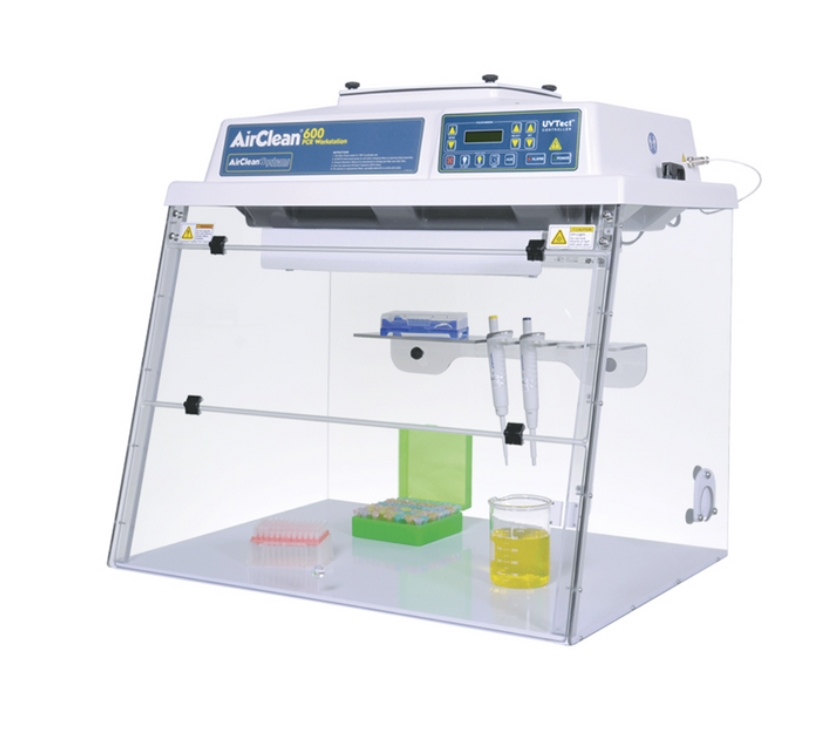Things to Consider When Purchasing Your PCR Workstation
Posted by Maxi Scientific on Sep 8th 2024
1. Contamination Control
One of the most critical factors when choosing a PCR workstation is minimizing contamination risks. PCR is highly sensitive, and even the slightest contamination can lead to false positives or skewed results.
- HEPA Filters: Look for workstations equipped with HEPA filters that remove airborne contaminants. A vertical or horizontal laminar airflow PCR workstation can help ensure a sterile environment by filtering the air as it enters the workspace.
- UV Light Sterilization: Many PCR workstations come with built-in UV lights for decontaminating surfaces and tools between experiments. UV light effectively destroys nucleic acids, reducing the risk of contamination.
- Antimicrobial Coatings: Some modern workstations feature antimicrobial surfaces that inhibit the growth of bacteria and other microorganisms, providing an extra layer of protection.
2. Size and Space Requirements
Workstation size is another crucial factor, particularly if your lab has limited space. Consider the number of samples, equipment, and reagents you'll need within reach during experiments.
- Compact Models: If you're working in a smaller lab or have space constraints, compact PCR workstations can save valuable benchtop space. They may have all the essential features without taking up too much room.
- Full-Sized Workstations: For labs processing a high volume of samples, full-sized PCR workstations with ample workspace and storage may be a better fit. These models provide enough room for multiple instruments and personnel to work simultaneously.
3. Ergonomics and Usability
PCR experiments can be time-consuming, requiring precision and long periods of focus. A workstation designed with ergonomics in mind will help reduce fatigue and improve workflow efficiency.
- Adjustable Workspaces: Some PCR workstations allow for height adjustments to accommodate different users. This feature can help reduce strain during long experiments.
- Visibility and Lighting: Ensure the workstation has sufficient lighting, and consider models with transparent side panels that provide a clear view of your workspace. This is particularly important when handling delicate samples or pipetting.
- User-Friendly Design: Workstations with easy-to-clean surfaces, intuitive controls, and clearly labeled buttons or dials make operation smoother, especially during high-pressure experiments.
4. Ventilation and Airflow
PCR workstations should provide proper ventilation to ensure that fumes and heat from equipment do not interfere with your work. However, airflow must be carefully managed to avoid disrupting delicate samples.
- Laminar Flow Hoods: As mentioned earlier, laminar flow PCR workstations maintain a constant flow of clean air across the workspace, preventing contaminants from settling on surfaces. Choose a model with consistent airflow to protect your samples.
- Exhaust Systems: If your lab uses chemical reagents or generates significant heat during PCR runs, workstations with exhaust systems are necessary to ensure proper ventilation.
5. Integration with Other Equipment
Modern PCR workstations often need to integrate with other instruments and technologies, such as thermal cyclers, pipetting robots, or sample storage systems. Consider your lab's existing equipment when choosing a workstation.
- Connectivity: Some workstations are designed to accommodate multiple instruments, with built-in ports for power and data connections. Make sure the workstation can handle all the equipment you need to operate smoothly.
- Automation Compatibility: If your lab is scaling up its operations or moving toward automation, look for PCR workstations compatible with automated systems. This can save time and reduce the risk of human error.
6. Budget and Maintenance
The cost of PCR workstations varies widely depending on the size, features, and level of sophistication. While it's essential to stay within your lab's budget, cutting corners can compromise the quality of your work.
- Initial Cost vs. Long-Term Value: High-end workstations with advanced contamination control, ergonomic design, and automation compatibility may have a higher upfront cost but offer better long-term reliability and performance.
- Maintenance: Consider the ease of cleaning and maintaining the workstation. UV lights and HEPA filters may need regular replacement, so factor in these recurring costs.
7. Compliance with Lab Standards
Finally, ensure that the PCR workstation you select meets the safety and compliance standards required for your field. This includes regulations for air filtration, chemical handling, and personnel protection.
- ISO Certifications: Many PCR workstations are certified to meet ISO standards for air quality, cleanliness, and safety. These certifications can give you peace of mind that your workstation will protect both your samples and your team.
- Biosafety Level: Depending on the type of work your lab conducts, you may need a PCR workstation that complies with specific biosafety levels (BSL-2, BSL-3, etc.). Verify that the model you choose meets the appropriate biosafety requirements.
Got any quesitons? Need a recommendation? Reach out to us at clientservices@maxisci.com!

